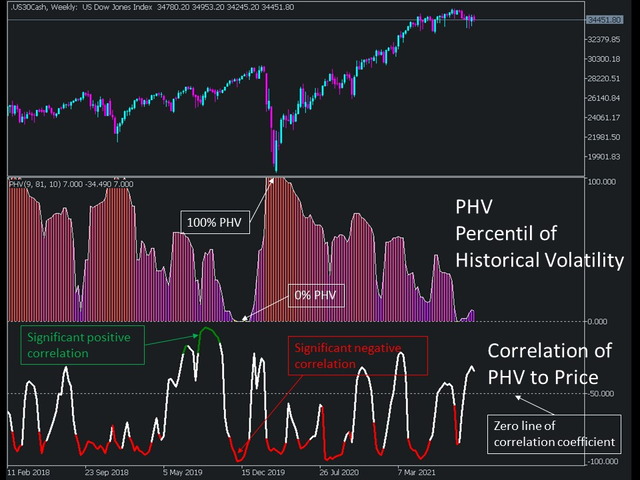Percentile of Historical Volatility and Correlation Coefficient shows if the asset currently is cheap or expensive based on the “usual” volatility. It is used to determine a good entry point. It has two indicators built in. Historical Volatility is ranked percentile wise and its correlation to price action which gives an indication of the direction of a future move. Together the both indicators can give good entries and direction.
Historical Volatility is a statistical measure of the dispersion of returns for an asset over a given period (Sample Size Historical Volatility). In this indicator the volatility model is calculated as the standard deviation of returns. Weighted with percentile with the given period (Sample Size Percentile). It shows the percentage of candles over the last selected period (Sample Size Percentile) where Historic Volatility was traded below the current level.
That means if PHV (Percentile of Historical Volatility) is at 5%, it was traded only 5% of the time (within percentile period) below that level. If PHV is above 80% it indicates, that historical volatility is higher than usual. So, a strategy could be, enter at a very low PHV, as it will likely expand and a bigger move will happen.
[spoiler title=”Read More…”]
The indicator values are displayed as Columns and range from 0 to 100 [%]. It is NOT a directional indicator, only together with Correlation it is possible to determine direction.
Correlation Coefficient is shown in the panel below the PHV to correlate the non-directional indicator to price, to make it directional. Traditional Pearson Correlation is used. It is shown as line and scaled. Usually, it goes from -1 to 1, for representation it is scaled to -100 to 0 (so -50 is zero line). The correlation line is coloured from the calculated p-value, based on significance confidence level of 0.05 (5%). If the correlation line turns “green” is shows significant positive correlation of PHV to price. If it turns “red” significant negative correlation is determined.
Example Strategies:
• PHV rising (percentile of historical volatility increasing) AND significant positive correlation = possible larger movement in price action to the upside expected (LONG)
• PHV rising (percentile of historical volatility increasing) AND significant negative correlation = possible larger movement in price action to the downside expected (SHORT)
• PHV falling (percentile of historical volatility decreasing) AND negative correlation = price will likely move slowly up (LONG)
• PHV falling (percentile of historical volatility decreasing) AND positive correlation = price will likely move slowly down (SHORT)
The Input Settings:
Sample Size Historical Volatility: Default 10, length of periods back to calculated historical volatility.
Sample Size Percentile: Default 100 (Recommendation use power of Sample Size Historical Volatility), length of periods back to calculated percentile of historical volatility.
Sample Size Correlation: Default 10, length of periods back to calculated correlation of PHV and Price
[/spoiler]





